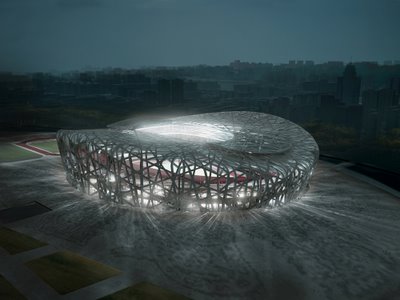




beijing olympic stadium by herzog & de meuron
Architectural Summary
The new National Stadium is located on a gentle rise in the centre of the Olympic complex. It is conceived as a large collective vessel. An undulating composition of high and low elevations moderates the bulk of the vessel and gives it a dramatic sweeping form. The stadium's appearance is pure structure. Facade and structure are identical. The structural elements mutually support each other and converge into a grid-like formation – almost like a bird's nest with its interwoven twigs. The spatial effect of the stadium is novel and radical and yet simple and of an almost archaic immediacy, thus creating a unique historical landmark for the Olympics 2008. The stadium is conceived as a large collective vessel which makes a distinctive and unmistakable impression both when it is seen from a distance and from close up. It meets all the functional and technical requirements of an Olympic National Stadium, but without communicating the insistent sameness of technocratic architecture dominated by large spans and digital screens. The spatial effect of the stadium is novel and radical and yet simple and of an almost archaic immediacy. Its appearance is pure structure. Facade and structure are identical. The structural elements mutually support each other and converge into a grid-like formation, in which facades, stairs and the roof are integrated. Visitors walk through this formation and enter the spacious ambulatory that runs full circle around the stands. From there one can survey the circulation of the entire area including the stairs that access the three tiers of the stands. Functioning like an arcade or a concourse, the lobby is a covered urban space with restaurants and stores that invite visitors to stroll around.The stands are designed without any interruption to evoke the image of a bowl. This evenly constructed shape serves to focus attention on the spectators and the events on the field. The human crowd forms the architecture. The facility provides good comfort, excellent views and a superb atmosphere. It will generate crowd excitement and drive athletes to outstanding performances.
The Exterior Shell – Inflated Cushions as a Filler
Just as birds stuff the spaces between the woven twigs of their nests with a soft filler, the spaces in the structure of the stadium will be filled with inflated ETFE cushions. On the roof, the cushions will be mounted on the outside of the structure to make the roof completely weatherproof. Whilst the rain is collected for rainwater recuperation the sunlight filters through the translucent roof providing the lawn with essential UV-Radiation. On the facade, the inflated cushions will be mounted on the inside of the structure where necessary, e.g. to provide wind protection. Since all of the facilities – restaurants, suites, shops and restrooms – are all self-contained units, it is possible to do largely without a solid, enclosed facade. This allows natural ventilation of the stadium which is the most important aspect of the stadium's sustainable design.
The Sliding Roof – the Lid of the Tin
The sliding roof is an integral part of the structure of the stadium. When it is closed, it converts the stadium into a covered arena. Just as a tin is only complete with a lid, the roof, whether closed or open, is an elementary part of the whole. With its own structural logic, it is also a grid-like formation that forms a waterproof shell together with the inflated cushions.
source: http://www.bjghw.gov.cn/forNationalStadium/indexeng.asp
No comments:
Post a Comment